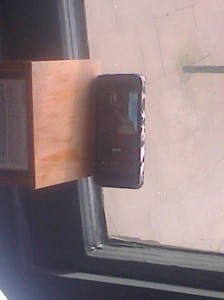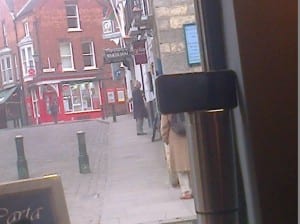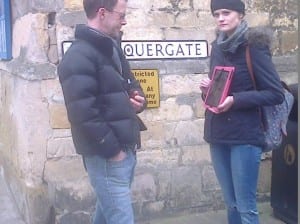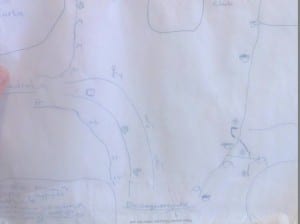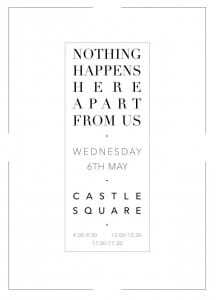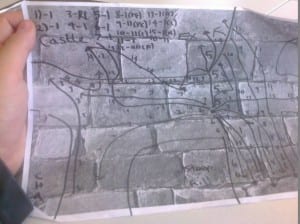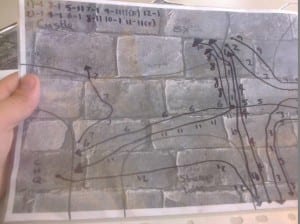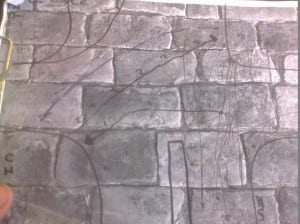Framing Statement
For Site Specific Performance, titled ‘Nothing happens here, apart from us’ our group wanted to explore the idea of surveillance and invasion of privacy that happens daily in the lives of the general public. Castle Square was the site we were given to develop this idea, castle square includes a prominent CCTV camera that is located in a central part of the square, above the Magna Carta Public House. This was our main inspiration, as we decided our performance would be an investigation into how the public use a busy and important place in the city like Castle Square. With inspirations such as the Surveillance Camera Players, Blast Theory and The Many Headed Monster, we wanted to achieve this by using three of us to follow the public through the square and documenting how they used the square and what direction they were heading.
We positioned two group members in the centre of the Square holding an iPad and a Go Pro to record how the public use the square and then play it back to them live. This was all done whilst facing the CCTV camera and moving in sync with the camera when it moves at certain points of the day. ‘We manifest our opposition by performing specially adapted plays directly in front of these cameras’ (Surveillance Camera Players, 2001) This shows where our main inspiration started to inspire us when thinking of ideas to include in our performance. The Surveillance Camera Players use CCTV cameras effectively to create and enhance thought provoking performances, if we copied what the CCTV camera does throughout a normal day through the context of real life performance. We could use our performance to educate the audience, to understand that their movements and actions are always being recorded.
Our Site Specific Performance was scheduled and performed on Wednesday 6th May; this date was useful as it was a convention md-week working day, with no outside events planned in Castle Square. This meant we could analyse and investigate the general public using the square in 3 different time slot throughout the day. The time slots were 9-9.30am, 12.30-1pm and 17.30-18.00pm; allowing us to see what our accidental audience were doing throughout the day. Encountering tourists, workers, locals, schoolchildren among others, gave us a well-rounded and diverse investigation.
In our performance, we didn’t have a conventional invited audience, that wouldn’t have fit in with our investigation as we were documenting people’s natural movements. Our audience throughout the day was accidental, as without them knowing about our investigation, they were the main bulk of our piece and made it a multi-dimensional performance. ‘The active participation of the audience is clearly a crucial element of the “metanatural” nature of the performance,’ ‘by taking the performance into “real life”’ (Auslander, et al, 2003, 376) this is what we attempted to do with our audience, by trying to make them participate in our performance that shows real life activity through performance.
Analysis of Process
Initial practical & theoretical ideas
The process was a time consuming, challenging yet creatively stimulating 5 month exploration into this type of performance that resulted in an interesting and thought provoking performance that pushed the idea of surveillance performance to the edge. The start of the process was much different compared to the final piece. During our initial trips up Steep Hill, I was initially mesmerized by the beauty of the steep hill area, the scale of the area and the architecture of the buildings located.
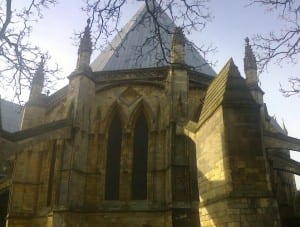
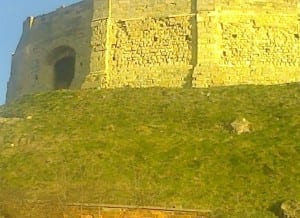
Analysing the sheer size and beauty of Lincoln Castle and Lincoln Cathedral, made me realize that I initially wanted to do my performance based around finding the beauty of these buildings not only on the outside but on the inside as well. ‘Moving through the flux of the city in awe of dazzling consumer spectacles: gazing, grazing, consuming. As scenes of the modern city channel my gaze and limit my objects of pleasure, my circulation becomes disciplined.’ (Pearson, 2010, 18) This quote symbolizes my initial thoughts of the tourist attractions in our site, as there were lots of pretty buildings, which made the decision hard at the start.
When taking a tour around steep hill, an important and changing and moment happened. I was taking notes and pictures of the views around me, therefore I was left tailing. This wasn’t a bad development as I then had a chance encounter with an annoyed disabled OAP local male who thought we were tourists, he said to me ‘Nothing happens here apart from us’. Those six words kept in my mind for the whole process, I was constantly thinking about what that sentence meant in relation to my performance. In the next two weeks, when touring Steep Hill that sentence was inspiring my thinking so much, that I wanted to base my piece about how the locals use Steep Hill, which happened. In the long run that sentence was extremely valuable to my performance.
Even though I had ideas in my mind regarding the final performance, it was still a long time to go before the fruition. The group I decided to work with in the space of 3 weeks included Tania Smart, Lucy Hind, Brittany Hine and Lily Bingham-Davis, the mutual idea we first decided on was based around mythology and the demons and witchcraft that surrounds Lincoln Cathedral. The reason why we chose this idea was because we were all interested in looking beneath the superficial exterior of a famous place like Lincoln Cathedral, to see what lies underneath and seeing if we can make a performance out of subsiding and fictionalising the truths
Jokingly we named the idea ‘Creepy face and Cobwebs’ as they were two factors that would’ve been included in our audio walk. When researching our story we wanted to present, we found that another ghost walk company based in the Cathedral was using the same subjects as us. We felt like we were going to plagiarise their idea, we wanted to be original, therefore deciding to scrap this idea and start to development a brand new one in a different area of Steep Hill.
First Developments
After the decision of cutting the Cathedral idea, our group had the idea of tracking people’s movements, as we were fascinated by the space that is Castle Square. For example people use Castle Square for lots of different reasons, when we first thought of this, 10 minutes went by with us observing what was happening in the square, during those 10 minutes there was everything from workers doing construction work to tourists taking photos.
This gave us the idea of using our performance as a form of documentation to see how the general public use Castle Square over the space of 4 months. ‘The connection between performance and document is thus thought to be ontological, with the event preceding and authorizing its documentation.’ (Auslander, 2006, 1) We tried to capture the idea of documentation as performance by situating mobile phones and technology such as iPads and Go Pro’s in key places of the square to capture everyday moments that make the square such an interesting performance space.
We had the idea of using time lapse footage which we recorded over a period of 3 weeks from numerous places in castle square such as the Magna Carta Public House, the benches in the square and also from the view looking up from steep hill. This was important for us as we gained footage from different of view focusing on more people, therefore showing more diversity in our piece, as evident in the images below.
The idea of using technology to enhance our piece on tracking and documenting the public’s movements, was inspired by Blast Theory. ‘Blast Theory is renowned internationally as one of the most adventurous artists’ groups using interactive media, creating ground-breaking new forms of performance and interactive art that mixes audiences across the internet, live performance and digital broadcasting.’ (Blast Theory, 2015) By using technology to visualise and enhance our performance, this shows the inspiration we gained from Blast Theory, as pieces they have done like ‘Ulrike and Eamon Complaint’ and ‘Digital Voices’ always involve technology like digital cameras, audio software and multimedia imagery to enhance and produce a ground-breaking contemporary form of experimental performance. With our idea of recording time-lapse footage of the general public then playing it back to the public live, that certainly had hallmarks of Blast Theories ideas and concepts. Finally the idea of having 4 people in the group holding iPads in 4 different directions with me documenting it by taking photos, came from the idea of using the space to maximum effect in order to gain more information to present a well-rounded and more interesting investigation.
‘The term refers to a staging and performance conceived on the basis of a place in the real world (ergo outside an established theatre). A large part of the work has to do with researching a place, often an unusual one that is imbued with history or permeated with atmosphere’ (Gleave, 2011, 2) This quote reiterates why we used all of Castle Square as it’s steeped in atmosphere and that inspired us as we wanted to make a piece that used the vibrant atmosphere that consists in Castle Square.
Initial Test Run and Feedback
The first initial test run of this idea we performed for Conan and Rachel, had its positive moments and contrastive criticism where we could draw inspiration from and improve our piece. For example when we presented our idea, we explained the iPads and the positioning in the square thoroughly explain why we are doing this to show how the general public use Castle Square. Conan liked the idea of surveilling the public’s movements and how by using footage we are mirroring what the general public do in an unsuspecting and natural way. However there were points he wanted to add to try and help us improve this idea, for example he was fixed on the CCTV camera that is overlooking and constantly recording the public in Steep Hill.
Conan suggested if we could incorporate the CCTV camera in our performance in any way, ‘It is estimated that there are five million CCTV cameras in use today. CCTV is used by a wide range of Organisations and for an increasing number of purposes.’ (Keval, 2009) With statistics like this found in this quote, we decided to use Conan’s feedback and use the CCTV camera in our performance, as we got thinking that is picking everything single thing that happens in Castle Square anyway, if we can mirror that camera and act like a well-rehearsed real life CCTV camera, then we can educate the general public and make them see that they’re constantly being watched by the government.
The other main point of constructive criticism Conan presented us with was the lacking use of direction and space in Castle Square, as he said the square is a unique space which has 4 exits and entrances you can use more by adding the use of direction when analysing the public’ movements, by trying to physically follow where they’re going in the square. ‘It broadens the types of relevant ‘spaces’ we might consider. The form also enables us to address a range of performative issues, from the development of site-specific ‘soundscapes’ to the role of the spectator in site-specific performance.’ (Birch et al, 2012) We decided to incorporate direction in our performance, making the visual aesthetic more pleasing to the audience rather than 4 static people holding iPads, the image below was taken during Conan’s feedback.
Continued Creative Development
After our meeting with Conan, the 4 weeks that’s followed before our dress rehearsals were an ever changing cauldron of performative ideas. The inclusion of the CCTV camera was a complex time in our process, as our idea was now focusing towards surveilling and intruding people’s movements and recording them live to act as a metaphor about surveillance. When developing this idea, we had a number of ideas in how to include the CCTV camera, for example we spent time and money trying to capture footage of a specific 30 minutes we spent in the square being recorded so we could stand directly opposite the camera and facing it showing the footage.
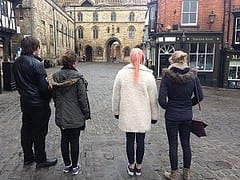
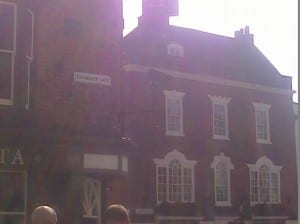
‘In reflecting upon the social engagement around the tool, (7) look beyond a common use of performance for exploring human-machine relations and implicitly consider the related area of performativity, or the creation of identity through repeated enactment.’ (Light and Wright, 2009) With the quote that was explaining the Panopticon of Performance Arena, we gained inspiration from this with our idea as with the CCTV ballet camera we were trying to see of the public acts in a different instinctive way even though their senses aren’t fully engrossed in the idea of being filmed. This idea would’ve created a CCTV ballet that was going to make our message to the public even clearer.
We hit a problem with that idea, the council who holds the footage wouldn’t give it to us under a Freedom of Information act when requested. This meant we couldn’t use the idea of having pre-recorded CCTV footage in line with live footage. We still wanted to use the iPads and the element of CCTV, as a group we decided to keep the CCTV as a big part of our performance by having Tania holding an iPad and Lily holding a Go Pro in the centre of the square and recording the public and playing the footage back live with turning at the same time of the CCTV camera, so we’re showing the public first-hand what a CCTV camera does every day.
Lucy, Brittany and I had the idea of following and documenting the movements of the public via a mapping. ‘The site-specific choreographer experiences and interacts with the site on a number of levels, metaphorically digging beneath the surface to reveal a uniquely personal interaction with the site.’ (Hunter, 2005,) As evidenced, we were allowing a personal interaction with the site by constantly walking through to see where the public leave their marks in the square. By mapping their movements we can show the results we got from our experiment at the conclusion of this whole process.
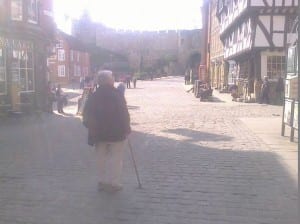
When going through a final idea two times before performance day, we made small final tweaks. When the public leave the square we’re going to down our tools and wait until more people come. If not then to present a united front, we are going back to the central hub, we believe these changes will present a smoother performance, the map results are below.
Evaluation
When evaluating our performance, I am first looking at the size of the audience. We didn’t advertise in the normal way with the poster above, we just had a poster there for clarity to prove that there was a performance happening on that day. As stated in the framing statement, we didn’t need to advertise, as our audience were accidental. Our performance still depended on how many numbers of people was using Castle Square on that day. Throughout the day, we were disappointed with the turnout of people using the square and interacting with our performance. The weather on that day was rain, this was a setback, in the first 30 minute period I followed 12 groups of people, with most of them either going up the exchequer gate or down Steep Hill. This was expected, in the morning most people were going to work or school, timing constraints didn’t help us, as they stop to engage with our piece.
Lunchtime was the most successful, I followed the same amount of people but got more diverse results, like tourists visiting the Cathedral. The central hub had interest and we gave out 3 flyers so they can see the results and explained to them about our investigation. The final evening slot was disappointing, heavy rain made my map wet therefore making it hard to write our results, there was no one going towards the hub as they were too busy avoiding the rain.
During the process, my thoughts on Castle Square as a performance site was mixed, visually the site was very pleasing and inspirational however practically it was hard to overcome barriers. The road in the middle which traffic used got in our way and the distractions in the square hurt us as they were distracting our accidental audience. On the day my thoughts slightly changed as the richness of entertainment gave us the perfect base to build our investigation around, our results reflect that as there are many routes to different places.
Positive factors of our performance include the diverse routes we documented as we were surprised on the difference as we wasn’t expecting this, also the fact that a Fudge Shop Owner actually talked to me about our piece and was interested in it. This showed us that people use castle square in different ways, this allowed us to present a well-rounded investigation. As evidenced in our results on https://www.flickr.com/photos/nothinghappenssite/sets/72157652870944665 as well as my own results below.
1st
3rd
We could’ve improved the final performance by making the central hub with the iPad and Go Pro more central in the square, as people were walking past it a lot not knowing it was there. Also the people who was documenting the audience could’ve been more noticed, by being more in sync with each other as I felt we were too formal sometimes and people just thought we were ‘Poncy Art Students’ according to one lady and didn’t take our performance seriously. If we was doing this performance again, I would alter the lack of vocal expression in our piece, I would make us communicate with the public more. To make them interested in what we were attempting, as we did get results but not as many especially from the iPad and Go pro as we were expecting.
Finally my engagement with the theory surrounding site specific performance, has helped me understand performances based in non-traditional venues. Through researching Mike Pearson and companies such as Blast Theory and Surveillance Camera Players, I now understand that unconventional spaces contain the basis of performativity and can be transformed and developed into performance idea.
Bibliography
Surveillance Camera Players (2001) Who are we & Why we’re here. (Online) New York: Surveillance Camera Players. Available from http://www.notbored.org/generic.jpg (Accessed 14 May 2015)
Auslander, P. (Eds) (2003) Performance: Visual art and performance art. New York: Routledge.
Pearson, M. (2010) Site-Specific Performance. Basingstoke: Palgrave Macmillan.
Auslander, P. (2006) THE PERFORMATIVITY OF PERFORMANCE DOCUMENTATION. Project Muse, Scholarly Journals Online, 28, (No.3) 1-10.
Blast Theory (2015) OUR HISTORY & APPROACH. (Online) Brighton: Blast Theory. Available from http://www.blasttheory.co.uk/our-history-approach/ (Accessed 14 May 2015)
Gleave, J. (2011) THE RECIPROCAL PROCESS OF THE SITE AND THE SUBJECT IN DEVISING SITE SPECIFIC PERFORMANCE. (Online) Birmingham. Available from: http://etheses.bham.ac.uk/3510/2/Gleave_12_MPhil.pdf (Accessed 15 May 2015)
Keval, H. (2009) Effective, Design, Configuration, and Use of Digital CCTV. (Online) London: University College London. Available from: http://discovery.ucl.ac.uk/15793/1/15793.pdf (Accessed 15 May 2015)
Birch, A., Tompkins, J. (Eds) (2012) Performing Site-Specific Theatre Politics, Place, Practice. Basingstoke: Palgrave Macmillan.
Light, A. and Wright, P. (2009) The Panopticon and the Performance Arena: HCI Reaches within. Sheffield: Sheffield Hallam University.
Hunter, V. (2005) Embodying the Site: the Here and Now in Site-Specific Dance Performance. (Online) Cambridge: Cambridge University Press. Available from: http://epubs.surrey.ac.uk/713934/3/Hunter%202005%20PUBLISHERs%20embodying%20the%20site%20NTQ.pdf (Accessed 15 May 2015)
Hine, B. (2015) Nothing happens here apart from us: The Results. (Flickr) 6th May. Available from https://www.flickr.com/photos/nothinghappenssite/sets/72157652870944665 (Accessed 15 May)

